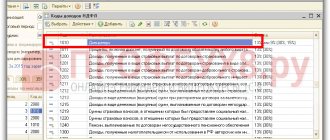Whose responsibility is the taxation of dividends?
The taxpayer for dividend income is the recipient. This can be either an organization or an individual. In the first case, income tax is paid on dividends, in the second - personal income tax. However, the direct responsibility to calculate, withhold and pay taxes on dividends lies with the company that distributes profits and pays dividends, since in this situation it acts as a tax agent (clause 3 of Article 275 of the Tax Code of the Russian Federation).
The responsibilities of a dividend tax agent also arise if the organization that is the source of payment applies special regimes (STS, UTII (until the end of 2021) or Unified Agricultural Tax). And for a recipient of dividends working under a special regime, the use of this regime does not prevent them from receiving dividends minus tax on them.
Property deduction for personal income tax from dividends in 2021
Property tax deduction in 2021: changes, clarifications Property deduction is regulated by Article 220 of the Tax Code of the Russian Federation. Anyone who receives taxable income at a rate of 13% can use it when purchasing and selling residential real estate in 2019.
Is it possible to reduce income from dividends by tax deductions? The founder of an LLC receives a salary and dividends in the company, he recently bought an apartment, is it possible to use 13% of the tax paid on dividends for a refund from the tax office according to the 3rd personal income tax declaration for the purchase of an apartment, the organization is simplified. No, income in the form of dividends cannot be reduced by tax deductions, including property ones, despite their taxation at a rate of 13%.
Algorithm for calculating tax on dividends
The formula by which taxes on dividends are calculated is given in paragraph 5 of Art. 275 of the Tax Code of the Russian Federation and has the following form:
N = K × Sn × (D1 - D2),
Where:
N - amount of tax on dividends to be withheld;
K is the ratio of the amount of dividends to be distributed in favor of their recipient to the total amount of dividends distributed by the organization;
Сн - tax rate;
D1 - the total amount of dividends distributed in favor of all recipients;
D2 - the total amount of dividends received by the organization itself in the current and previous reporting (tax) periods, provided that they were not previously taken into account when calculating income; This figure does not include dividends, which are subject to a zero income tax rate.
From 2021, a company that receives and pays dividends will calculate tax differently. From indicator D2 you will need to exclude the amount:
- dividends taxed at a 0% rate from an international company that owns a share or contribution of more than 15% for more than a year;
- dividends from foreign enterprises that the company received through Russian organizations and to which it has the actual right. It does not matter whether such dividends were subject to income tax for the recipient or whether tax was calculated on them at a 0% rate.
According to the above formula, both income tax on dividends paid to organizations and personal income tax on dividends in favor of individuals are calculated (clause 2 of Article 210 of the Tax Code of the Russian Federation, letter of the Ministry of Finance of Russia dated June 17, 2015 No. 03-04-06/34935).
However, it is not used when calculating taxes on dividends in favor of foreign companies and individuals - non-residents of the Russian Federation. For them, taxes are calculated based on the full total amount of dividends distributed by the organization (clause 6 of Article 275 of the Tax Code of the Russian Federation). If the final recipients of such a payment are individuals or legal entities who are residents of the Russian Federation, then the prohibition on using the above formula does not apply to payments to non-residents.
Nuances of calculating taxes on dividends
When calculating tax on dividends, it is important to consider the following features:
- The total amount of distributed dividends (in the formula this is indicator D1 and the denominator of indicator K) includes, among other things, dividends in favor of:
- foreign - non-residents of the Russian Federation.
This follows directly from paragraph 5 of Art. 275 of the Tax Code of the Russian Federation (as well as from letters of the Ministry of Finance of Russia dated July 8, 2014 No. 03-08-05/33030 and the Federal Tax Service of Russia dated August 12, 2014 No. GD-4-3 / [email protected] ).
- The total amount of dividends should include those from which the “profitable” tax is not withheld (paragraph 6, paragraph 5, article 275 of the Tax Code of the Russian Federation). In particular, dividends on shares that are state or municipally owned or that constitute the property of mutual funds and public legal entities (letter of the Ministry of Finance of Russia dated June 11, 2014 No. 03-08-05/28295).
- Dividends for past periods are taxed at the rate that is established on the date of issue of these dividends (letter of the Federal Tax Service of Russia for Moscow dated March 14, 2007 No. 20-08 / [email protected] ).
- Indicator D2 takes into account dividends (not counting those taxed at a zero rate) received from both domestic and foreign companies. Moreover, they are taken into account in the so-called pure form, that is, without the tax that the source of payment withheld from them (letter of the Ministry of Finance of Russia dated June 11, 2014 No. 03-08-05/28295).
- If the calculation results in a negative tax amount, then the agent does not need to pay tax. But he won’t be able to get the difference from the budget. This is directly stated in paragraph. 9 clause 5 art. 275 Tax Code of the Russian Federation.
- An organization paying dividends through tax agents must notify about the values of indicators D1 and D2 used in the calculation no later than 5 days from the date of determining the circle of persons entitled to receive dividends (if the organization is an issuer), but no later than the day of their payment each of the tax agents. Notification is carried out by sending information electronically or on paper or posting it on the website or in a payment document for the transfer of money (clauses 5.1 and 5.2 of Article 275 of the Tax Code of the Russian Federation).
At what rates are taxes on dividends calculated?
If we talk about income tax, then its rate in relation to dividends depends on who the recipient is - a Russian or foreign company (clause 3 of Article 284 of the Tax Code of the Russian Federation).
If income is paid to a foreign company, dividend tax is calculated at a rate of 15%.
If the recipient is a domestic organization, in most cases a rate of 13% is applied.
An exception is the payment of dividends to an organization that, on the day the decision on payment is made, has continuously owned for at least 365 calendar days:
- at least half of the share in the authorized capital of the company paying dividends;
- or depositary receipts giving the right to receive at least half of the total amount of dividends paid.
A 0% rate applies to such dividends.
The right to a zero rate must be justified. This must be done by the taxpayer who receives the dividends. To do this, he submits to the Federal Tax Service documents confirming the date of origin of ownership of the share in the management company or depositary receipts. He must submit the same documents to the agent company along with confirmation of their submission to the tax office. This is what the Russian Ministry of Finance thinks (letters dated 02/24/2009 No. 03-03-06/1/78, dated 06/09/2008 No. 03-03-06/2/68).
The personal income tax rate depends on the status of the individual receiving the income (Article 224 of the Tax Code of the Russian Federation):
- For a resident of the Russian Federation, dividend tax is withheld at a rate of 13%;
- non-resident - at a rate of 15%.
You can transfer personal income tax withheld from dividends of several “physics” participants in one payment.
Article 43 of the Tax Code of the Russian Federation. Dividends and interest (current version)
The appellate court found that payments were made to the company's participants from the retained profits of previous years not in proportion to the participants' share in the authorized capital, but in proportion to the contributions made by the participants to the company's property. Guided by the provisions of Articles 43, 214, 224, 226 and 275 of the Tax Code of the Russian Federation, Article 28 of Law No. 14-FZ, the appellate court came to the conclusion that the amounts paid by the company in amounts exceeding dividends proportional to the shares of participants in the authorized capital of the organization, for For tax purposes, personal income tax is not recognized as dividends; they are other income of an individual and are subject to taxation at a rate of 13 percent.
According to the Federal Antimonopoly Service of the North-Western District, this conclusion of the court is based on the correct application of substantive law.
In accordance with the provisions of Article 43 and paragraph 4 of Article 224 of the Tax Code of the Russian Federation, part of the net profit of the company, distributed among its participants in proportion to their shares in the authorized capital of the organization, is recognized for the purposes of personal income tax as the payment of dividends, in respect of which a preferential tax rate is established 9 percent.
In the event of a disproportionate distribution of profits between the participants of the company, amounts paid in excess of dividends proportional to the share in the authorized capital of the organization should be qualified in accordance with subparagraph 10 of paragraph 1 of Article 208 of the Tax Code of the Russian Federation as other income of an individual that is not recognized for the purposes of taxation on personal income. dividends, and a rate of 13 percent is applied to these payments (clause 1 of Article 224 of the Tax Code of the Russian Federation).
At the same time, the appellate court found that the tax authority, during an on-site audit, qualified all amounts paid to the company's participants as other income of individuals, subject to personal income tax at a rate of 13 percent.
This approach of the tax authority was recognized as unlawful.
A similar position is set out in the Resolution of the Federal Antimonopoly Service of the Moscow District dated May 25, 2009 N KA-A41/4239-09.
In the letter of the Ministry of Finance of Russia dated May 14, 2015 N 03-03-10/27550 it is explained that the provision of paragraph 1 of Article 43 of the Tax Code of the Russian Federation, establishing the definition of dividends for the purposes of the Tax Code of the Russian Federation, includes not only the income received by the shareholder from the organization during distribution as dividends as such profit remaining after taxation on the shares owned by the shareholder, but also similar income received by the participant on the shares owned by him.
In a letter dated 06/05/2015 N 03-03-10/32629, the financial department indicates that since the distribution of the organization’s property during its liquidation between shareholders (participants) is made after satisfying the claims of all creditors, that is, payment of all obligations, including obligations for taxes and fees , such payments are actually aimed at distributing the net profit of this organization and satisfy the definition of dividends established by paragraph 1 of Article 43 of the Tax Code of the Russian Federation.
Consequently, if the value of the property received by shareholders (participants) during the distribution of the property of the liquidated company exceeds their contribution to the authorized capital of the liquidated organization, then such excess is recognized as dividends.
It should be noted the position of the Federal Antimonopoly Service of the North Caucasus District in Resolution N F08-4484/2003-1712A dated November 12, 2003, according to which the amounts forming the property of a unitary enterprise are not income from equity participation in another enterprise in the sense given in the Tax Code of the Russian Federation , and can be regarded as assets received free of charge.
As the court noted, the property of the enterprise was entirely formed at the expense of the founder, therefore, within the meaning of this norm, funds transferred free of charge between the enterprise and the founder are not income from equity participation in the activities of another enterprise.
Thus, since the disputed transfers are not income from equity participation in another enterprise, the plaintiff is not a tax agent and is not obliged to withhold this tax at the source of payment.
Interest is any previously declared (established) income, including in the form of a discount, received on a debt obligation of any type (regardless of the method of its execution).
Thus, non-operating income generated by an organization that is a bankruptcy creditor in the form of accrued interest on the amount of the bankruptcy creditor’s claims against the debtor from the date of commencement of bankruptcy proceedings until the date of repayment of these claims by the debtor is recognized as income in the form of accrued interest, and not in the form of penalties, since in order to collect of the specified interest from the debtor, neither his recognition nor a court decision on the collection of interest is required.
The Ministry of Finance of Russia in letter dated 04/01/2011 N 03-03-06/2/60 came to a similar conclusion.
Concluding a loan agreement in a currency other than the currency of the Russian Federation is permitted in accordance with paragraph 2 of Article 317 of the Civil Code of the Russian Federation if the monetary obligation stipulates that it is payable in rubles in an amount equivalent to a certain amount in foreign currency or in conventional monetary units. In this case, the amount payable in rubles is determined at the official exchange rate of the relevant currency or conventional monetary units on the day of payment, unless a different rate or another date for its determination is established by law or by agreement of the parties.
In conditions of increased volatility of the foreign exchange market, potential lenders are interested in concluding agreements, the subject of which are foreign currency obligations. Banks and microfinance organizations often nominate borrowed funds in foreign currency, and transfers are made in Russian rubles at the Bank of Russia exchange rate on the date of transfer.
Taking into account the dynamics of exchange rate changes, situations arise in which the amount of funds in rubles paid to the lender when repaying the loan amount significantly exceeds the amount of funds received by the borrower at the conclusion of the agreement, but at the same time insufficient for the lender to purchase an amount expressed in foreign currency on the foreign exchange market currency and which is the subject of the loan agreement.
Back at the end of 2012, the Supreme Arbitration Court of the Russian Federation formulated a position according to which, when the borrower returns the loan amount expressed in foreign currency, recalculated into rubles on the date of return, there is no economic benefit for individual lenders, since in fact the borrower returns the loan amount established in the agreement. Chapter 23 of the Tax Code of the Russian Federation does not contain any provisions allowing such positive differences to be considered in the quality of income (Resolution of the Presidium of the Supreme Arbitration Court of the Russian Federation dated November 6, 2012 N 7423/12).
In 2021, the Federal Tax Service of Russia, in connection with an appeal on the procedure for taxing personal income in the form of a positive exchange rate difference arising in connection with changes in the exchange rate of foreign currency to the ruble, referred to this position and recalled that in the case where written explanations of the Ministry of Finance of Russia (recommendations , explanations of the Federal Tax Service of Russia) on the application of the legislation of the Russian Federation on taxes and fees are not consistent with the decisions, resolutions, information letters of the Supreme Arbitration Court of the Russian Federation, as well as decisions, resolutions, letters of the Supreme Court of the Russian Federation, tax authorities, starting from the date of placement in full to the extent of the specified acts and letters of the courts on their official websites on the Internet or from the date of their official publication in the prescribed manner, when exercising their powers, they are guided by the specified acts and letters of the courts.
Thus, the tax authority agreed with the position that there is no object of taxation in the form of a positive difference that arises when recalculating the loan amount at the Bank of Russia exchange rate on the date of repayment of the loan (letter of the Federal Tax Service of Russia dated January 21, 2016 N BS-4-11 / [email protected] ).
How to report taxes on dividends
It is important for a tax agent not only to correctly calculate taxes on dividends, but also to report them to the Federal Tax Service.
Income tax on dividends paid to domestic companies is reflected in the usual “profit” declaration:
- The tax calculation itself is in section A of sheet 03;
- breakdown of dividend recipients - in section B of sheet 03;
- amounts payable - in subsection 1.3 of section 1.
For the tax on dividends of foreign companies, a tax calculation (information) is provided on the amounts of income paid to foreign organizations and taxes withheld. Its form was approved by order of the Federal Tax Service of Russia dated March 2, 2016 No. ММВ-7-3/ [email protected]
The deadlines for submitting a profit declaration and tax calculations coincide (clause 4 of Article 310 of the Tax Code of the Russian Federation). Their last date is defined as the 28th calendar day from the end of the reporting period (clause 3 of Article 289, clause 2 of Article 285 of the Tax Code of the Russian Federation), and for the annual report - as March 28 of the next year (clause 4 of Article 289, Clause 4 of Article 310 of the Tax Code of the Russian Federation).
Dividends paid to individuals are reflected in 2-NDFL certificates, annually submitted to the Federal Tax Service and handed over to the individual (clauses 2, 4 of Article 230 of the Tax Code of the Russian Federation). If information on the payment of income is submitted by a tax agent recognized as such under Art. 226.1 of the Tax Code of the Russian Federation (transactions with securities, derivative financial instruments, payments on securities of Russian issuers), and this agent submitted to the Federal Tax Service data on payments made as part of the profit declaration submitted by him (in Appendix 2 to it), then certificates 2- He does not need to submit personal income tax to the Federal Tax Service (clause 4 of Article 230 of the Tax Code of the Russian Federation, letter of the Federal Tax Service of Russia dated 02.02.2015 No. BS-4-11 / [email protected] ).
From the report for the 1st quarter of 2021, 2-NDFL certificates are submitted to the Federal Tax Service as part of form 6-NDFL.











